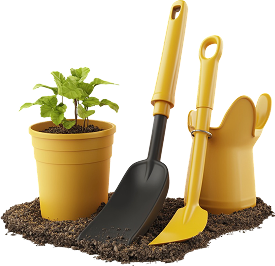From Grinding to Rotting: All the Ways to Remove Tree Stumps
Tree stumps can be an eyesore, a tripping hazard, and an obstacle to new landscaping projects. Once a tree is cut down, most property owners are left wondering what to do with the remaining stump. Fortunately, there are several reliable methods for removing tree stumps, each suited for different needs, budgets, timelines, and soil conditions. In this comprehensive guide, we'll cover everything you need to know about the best methods for getting rid of tree stumps, including stump grinding, burning, chemical rotting, manual removal, professional services, and more.

Why Remove Tree Stumps?
Before diving into the various stump removal methods, it's critical to understand why stump removal matters for both homeowners and landscape professionals. Tree stumps can:
- Attract pests and termites, risking infestation to nearby healthy trees and your home.
- Regrow into new trees via suckers, especially for certain species like willows or poplars.
- Interfere with lawn maintenance, mowing, or landscaping plans.
- Cause injuries as tripping hazards.
- Reduce property value and curb appeal, especially with decaying or fungal-ridden stumps.
Overview: Popular Tree Stump Removal Methods
Every tree stump is unique--its size, age, location, and wood hardness will affect the best removal technique. Here's a quick overview of your top choices:
- Stump Grinding - Fast, powerful, and commonly used by professionals.
- Manual Removal - Best for smaller or shallow-rooted stumps.
- Chemical Rotting - Uses store-bought chemicals to accelerate natural stump decay.
- Burning - For rural or permitted areas, burning can quickly break down stumps.
- Natural Rotting - Accelerating decomposition with organic substances.
- Excavation/Heavy Machinery - For large stumps or construction zones.
- Professional Stump Removal Services - When in doubt, let the pros handle it!
1. Stump Grinding: The Fast and Efficient Choice
What is Stump Grinding?
Stump grinding is the most popular modern method for eliminating tree stumps. It involves a specialized machine called a stump grinder, equipped with a rotating cutting disc that chips away the wood just below ground level. This process:
- Quickly shreds the visible stump and large roots into mulch.
- Makes it possible to replant or lay sod almost immediately.
- Eliminates the eye-sore within hours, not weeks.
When to Choose Stump Grinding
Stump grinding is best for homeowners who need:
- To quickly remove a tree stump with minimal impact on the landscape.
- A solution for large, hardwood tree stumps.
- Minimal soil disturbance and ready-to-plant results.
For small stumps, you may rent a small grinder. For large or challenging stumps, professional stump grinding services are recommended for safety and thorough results.
Pros and Cons of Stump Grinding
- Pros: Fast, effective, little regrowth, immediate results, good for almost all stump sizes.
- Cons: Rental/contractor costs, can't remove all deep roots, machinery required, potential flying debris.
2. Manual Removal: Old School Muscle & Tools
How to Manually Remove a Tree Stump
Small stumps or those with shallow root systems can often be removed with hand tools like a shovel, digging bar, mattock, or axe. The process generally includes:
- Digging around the base of the stump to expose roots.
- Using a saw or axe to cut major roots and disconnect the stump from the ground.
- Leverage the stump out using a pry bar or by pulling with a vehicle (for tough stumps).
When Manual Removal Works Best
- For stumps less than 8 inches in diameter.
- With softwood species and recently cut stumps.
- When access for machinery is limited (tight locations, next to structures).
Though cost-effective, this method is labor-intensive and may not work for mature, deeply rooted stumps.
Pros and Cons of Manual Stump Removal
- Pros: Cheap, simple, eco-friendly, good exercise!
- Cons: Time-consuming, physically demanding, not suitable for all stumps.
3. Chemical Stump Removal: Accelerate Natural Decay
What Is Chemical Stump Removal?
Chemical rotting or chemical stump removal uses commercially available products--usually potassium nitrate or other stump removers--to speed up the natural decomposition of stump wood.
The process is straightforward:
- Drill deep holes in the stump's surface and top roots.
- Fill holes with purchased stump remover chemicals.
- Soak with water and cover to prevent rain dilution.
- Over several weeks or months, the stump softens and rots.
Best Uses for Chemical Stump Rotting
- For homeowners preferring a less labor or machinery dependent solution.
- On stumps in areas where digging or burning is impractical.
- For accelerating decomposition before using other techniques like burning.
Chemical rotting is not immediate--it can take several months for large or dense stumps to decompose. Always use chemical products according to label directions for safety and environmental protection.
Pros and Cons of Chemical Stump Removal
- Pros: Little physical effort, low impact, inexpensive products available at garden centers.
- Cons: Slow process, can harm nearby plants if misapplied, not suited for urgent projects or large stumps.
4. Burning Out a Stump
How Burning Tree Stumps Works
If allowed by local ordinances, you can burn out a tree stump by either making a controlled fire atop or boring holes, filling them with kerosene (never gasoline!) and lighting it.
The basic steps:
- Drill holes and pour in fuel (kerosene or stove oil). Let soak deeply.
- Ignite the stump and monitor the burn closely for safety.
- After the burn, break apart softened wood and fill the hole with soil.
When Is Burning Appropriate?
- In rural or remote areas where burning is legally permitted.
- For dry, seasoned stumps (fresh stumps generally won't burn well).
- Where rapid removal is desired and smoke/nuisance is not an issue.
Always check local fire codes and environmental regulations before attempting this method. Never leave a burning stump unattended!
Pros and Cons of Burning Stumps
- Pros: Effective, especially after other decay or chemical treatment.
- Cons: Fire hazard, requires patience and vigilance, not always legal.
5. Natural Rotting Using Composting and Organic Agents
How to Naturally Rot a Stump
If you're in no rush, natural tree stump decomposition can be encouraged by:
- Drilling holes and packing them with high-nitrogen substances like blood meal, composted manure, or even high-nitrogen fertilizer.
- Keeping the stump moist and covered with soil or mulch to retain heat and encourage fungus growth.
- Repeating applications every few months for best results.
Pros and Cons of Natural Rotting
- Pros: No chemicals, low cost, environmentally friendly, improves soil as it decomposes.
- Cons: Very slow (can take one to several years), not suitable for those needing quick removal.
6. Excavation or Heavy Machinery
When To Use Heavy Equipment
For massive tree stumps or construction-grade projects, excavation using a small backhoe or skid-steer is the fastest solution. This is typically performed by professionals with:
- Bulldozers, backhoes, or diggers for extremely large or numerous stumps.
- Major land clearing or site preparation needs.
While highly effective, this method leaves a much larger hole and can be costly, so it's best reserved for big projects or land development.
7. Professional Stump Removal Services: When To Call the Experts
Not every homeowner wants to rent powerful machinery, handle potentially hazardous chemicals, or spend weekends hacking out a stubborn stump. Professional stump removal companies offer:
- State-of-the-art stump grinding, excavation, or chemical removal methods.
- Peace of mind with full insurance and expertise.
- Time savings for large, tough, or risky stumps.
- Guaranteed clean-up of stump chips, roots, and debris.

Stump Removal FAQs
How do I choose the best stump removal method for my situation?
Pick your approach based on:
- The stump's size and species.
- Your budget, timeline, and physical capacity.
- Access to tools or machinery.
- Environmental and legal restrictions (such as burning bans).
Can I plant a new tree after stump removal?
After removing a tree stump (especially by grinding or digging), you can generally replant immediately, but it's wise to dig out as many roots as possible, replenish soil nutrients, and choose a new location slightly offset to reduce pest or disease risks.
Is stump removal necessary for every cut tree?
While not always strictly necessary, removing tree stumps prevents regrowth, insect/fungal infestations, and improves lawn and garden aesthetics and safety.
Conclusion: The Smartest Way to Remove Tree Stumps
From grinding to rotting and everything between, there's an ideal tree stump removal method for every scenario. For immediate results and a yard ready for replanting, stump grinding is the gold standard. For those on a budget or with time to spare, chemical rotting and natural decomposition offer low-labor solutions. In some cases, burning or excavation may be suitable, provided local rules allow.
Ultimately, the right stump removal approach will restore your landscape's beauty and value, eliminate potential hazards, and clear the way for new outdoor dreams. Whether you tackle the work yourself or hire a professional, understanding the full spectrum of tree stump removal methods will ensure a safer, healthier, and more attractive property.
